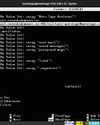THE X FILES
Linux Format
|August 2021
Jonni Bidwell wants to know why a middle-aged display server is still at the heart of the Linux desktop.

Last issue we studied Ubuntu 21.04, which marks the distro’s shift from the X.org display server to Wayland (on amenable hardware). But this isn’t the first time Canonical tried using Wayland by default.
Ubuntu 17.10 shipped with this configuration, but users were displeased. Come to think of it, Ubuntu 17.10 (Artful Aardvark) also had an artful habit of bricking Lenovo laptops and had to be re-released. And it was disliked by fans of the Unity desktop who saw their favourite desktop replaced by Gnome. Anyway, that Wayland experiment never made it to the next Ubuntu LTS (Breezy Badger), and nor is it present in the current LTS (Focal Fossa). Things have stabilised by now, so barring any mishap the next Ubuntu LTS will finally make the shift to Wayland.
But why do we need Wayland? And what exactly is this X thing anyway? The answers are complex and have lengthy stories behind them. But hopefully this feature adds at least a small amount of clarity to the situation.
Ultimately, X has been with us for over 30 years, and it has no business serving the displays and running the applications that modern workloads entail. Wayland has been with us a while, too. It was first dreamed up in 2008 and has been powering devices (just not necessarily Linux desktop PCs) from the get-go. It’s been the default on Fedora for ages, and probably works just fine on other distros, too. Maybe even better than fine…
Dit verhaal komt uit de August 2021-editie van Linux Format.
Abonneer u op Magzter GOLD voor toegang tot duizenden zorgvuldig samengestelde premiumverhalen en meer dan 9000 tijdschriften en kranten.
Bent u al abonnee? Aanmelden
MEER VERHALEN VAN Linux Format

Linux Format
Create your first WebSocket service
Mihalis Tsoukalos explains how to use the Go programming language to work with the WebSocket protocol.
9 mins
April 2023

Linux Format
Fantastic Mr Firefox
Nick Peers takes a trip down memory lane to reveal the story behind the rise - and slight fall - of Mozilla's popular web browser.
9 mins
April 2023

Linux Format
Set up your terminal and email like it's 1983
Jump in the hot terminal time machine with Mats Tage Axelsson who emails from the command line using the latest technology.
8 mins
April 2023

Linux Format
Universal layer text effects with GIMP
Posters use them, films and presentations are hard to imagine without them: text effects. Attract attention with Karsten Günther and GIMP.
8 mins
April 2023

Linux Format
Jump to a federated social network
Nick Peers reveals how you can get up and running with this free, decentralised and non-profit alternative to Twitter.
9 mins
April 2023

Linux Format
Free our SOFTWARE!
Taking anything for granted is dangerous, so Jonni Bidwell and Mike Saunders revisit how the free software movement got started to help free us from proprietary tyranny!
4 mins
April 2023

Linux Format
Master RPI.GPIO
Les Pounder goes back to the early days of the Raspberry Pi - and his career with this classic library! -
5 mins
April 2023

Linux Format
Waveshare Zero to Pi3
Transform your Pi Zero into a Pi 3, they promised Les Pounder, but it's more like adding on go-faster stripes.
2 mins
April 2023

Linux Format
The Best OPEN SOURCE Software Ever!
In an attempt to trigger controversy, Michael Reed and Neil Mohr unequivocally state these are the greatest free software apps ever. Probably. We’re just trying to be helpful.
19 mins
April 2023

Linux Format
Linux-Mandrake 7
Simplicity and a wide range of applications make this a great distribution for all Linux users.
2 mins
April 2023
Translate
Change font size

